Vodafone VFD 710 User Manual
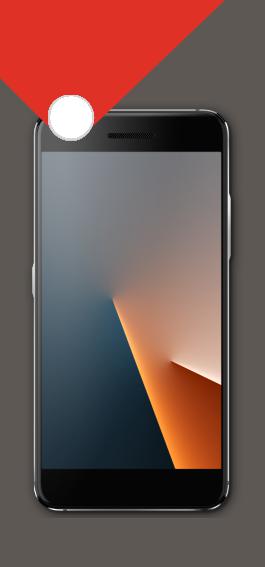
Smart V8
User manual
VFD 710

About this manual
Thank you for choosing this mobile phone. In order to keep your phone in its best condition, please read this manual and keep it for future reference.
Copyright
Copyright © 2017 Vodafone Group All rights reserved.
No part of this publication may be quoted, reproduced, translated or used in any form or by any means, electronic or mechanical, including photocopying and microfilm, without the prior written permission of Vodafone Group.
Notice
Vodafone Group reserves the right to make modifications on print errors or update specifications in this guide without prior notice. This manual has been designed with the utmost care to ensure the accuracy of its content. However, all statements, information and recommendations contained therein do not constitute a warranty of any kind, either expressed or implied. We offer self-service for our smart terminal device users.
Disclaimer
Vodafone Group expressly disclaims any liability for faults and damages caused by unauthorised modifications of the software.
Images and screenshots used in this manual may differ from the actual product. Content in this manual may differ from the actual product or software.
Trademarks
Google and Android are trademarks of Google, Inc.
The Bluetooth® trademark and logos are owned by the Bluetooth SIG, Inc. and any use of such trademarks by Vodafone Group is under license.
microSDXC Logo is a trademark of SD-3C, LLC.
2
Qualcomm® Snapdragon™ processors are products of Qualcomm Technologies, Inc.
Qualcomm and Snapdragon are trademarks of Qualcomm Incorporated, registered in the United States and other countries. Used with permission.
Other trademarks and trade names are the property of their respective owners.
Version No.: R1.0
Edition Time: February 6, 2017
3
Contents
Getting started.......................................................... |
8 |
Getting to know your phone ................................................. |
8 |
Knowing the keys...................................................................... |
9 |
Installing the nano-SIM card and the microSD™ card.. |
9 |
Charging the battery.............................................................. |
10 |
Extending the battery life..................................................... |
11 |
Powering on/off....................................................................... |
12 |
Setting up for the first time ................................................. |
12 |
Locking/unlocking the screen and keys........................ |
12 |
Using the touch screen ........................................................ |
13 |
Getting to know the home screen .................................... |
15 |
Personalising......................................................... |
17 |
Changing the system language......................................... |
17 |
Setting the date and time .................................................... |
17 |
Changing ringtone and notification sound ................... |
17 |
Turning on/off system sounds ........................................... |
18 |
Adjusting volume.................................................................... |
18 |
Using do not disturb mode.................................................. |
18 |
Applying new wallpapers...................................................... |
20 |
Changing screen brightness ............................................... |
21 |
Using night mode ................................................................... |
21 |
Protecting your phone with screen locks ...................... |
21 |
Using your fingerprint ........................................................... |
22 |
Protecting your phone with screen pinning.................. |
23 |
Knowing the basics.............................................. |
24 |
Monitoring the phone status .............................................. |
24 |
Managing notifications ......................................................... |
24 |
Managing shortcuts and widgets ...................................... |
27 |
Organising with folders ......................................................... |
27 |
Rearranging the primary shortcuts .................................. |
28 |
Entering text.............................................................................. |
28 |
Editing text................................................................................. |
31 |
Opening and switching apps............................................... |
31 |
Use two apps in split-screen mode ................................... |
32 |
Uninstalling an app................................................................. |
32 |
4 |
|
Hiding apps................................................................................ |
33 |
Connecting to networks and devices ............. |
34 |
Connecting to mobile networks........................................ |
34 |
Connecting to Wi-Fi................................................................ |
35 |
Using Wi-Fi Direct® .................................................................. |
37 |
Connecting to Bluetooth devices ..................................... |
37 |
Exchanging data via NFC....................................................... |
39 |
Using tap & pay ........................................................................ |
40 |
Connecting to your computer via USB............................ |
40 |
Using USB On-The-Go (OTG) ............................................... |
41 |
Using the microSD card as portable or phone storage |
|
....................................................................................................... |
41 |
Sharing your mobile data connection............................. |
44 |
Connecting to virtual private networks .......................... |
46 |
Phone calls ............................................................. |
48 |
Placing and ending calls ...................................................... |
48 |
Answering or rejecting calls................................................ |
49 |
Working with the call history.............................................. |
49 |
Calling your contacts ............................................................. |
50 |
Checking voicemail................................................................ |
50 |
Using options during a call.................................................. |
51 |
Managing multi-party calls.................................................. |
51 |
Adjusting your call settings................................................. |
52 |
Contacts ................................................................... |
56 |
Checking contact details...................................................... |
56 |
Adding a new contact ............................................................ |
56 |
Setting up your own profile................................................. |
56 |
Importing, exporting, and sharing contacts .................. |
57 |
Working with favourite contacts......................................... |
58 |
Searching for a contact ......................................................... |
58 |
Editing contacts ....................................................................... |
58 |
Web accounts ......................................................... |
61 |
Adding or removing accounts ............................................ |
61 |
Configuring account sync.................................................... |
61 |
Email......................................................................... |
63 |
Setting up the first email account .................................... |
63 |
5 |
|
Checking your emails............................................................ |
63 |
Responding to an email........................................................ |
63 |
Writing and sending an email ............................................. |
64 |
Adding and editing email accounts.................................. |
65 |
Changing general email settings ...................................... |
65 |
Message+ ................................................................ |
66 |
Opening the Message+ screen........................................... |
66 |
Sending a message................................................................. |
66 |
Replying to a message .......................................................... |
66 |
Forwarding a message........................................................... |
67 |
Messaging............................................................... |
68 |
Opening the Messaging screen.......................................... |
68 |
Sending a message................................................................. |
68 |
Replying to a message .......................................................... |
68 |
Forwarding a message........................................................... |
69 |
Copying a message................................................................. |
69 |
Web browser........................................................... |
70 |
Opening the browser ............................................................. |
70 |
Using multiple browser tabs................................................ |
70 |
Downloading files ................................................................... |
70 |
Changing Chrome settings.................................................. |
71 |
Camera .................................................................... |
72 |
Capturing a photo................................................................... |
72 |
Recording a video ................................................................... |
73 |
Using manual camera mode .............................................. |
74 |
Using other camera modes................................................. |
75 |
Customising camera/camcorder settings ..................... |
75 |
Gallery...................................................................... |
77 |
Opening gallery ....................................................................... |
77 |
Working with albums ............................................................. |
77 |
Working with pictures............................................................ |
77 |
Retouching your pictures .................................................... |
78 |
Making a GIF picture or a collage ...................................... |
79 |
Playing videos .......................................................................... |
80 |
Music........................................................................ |
81 |
6 |
|
Viewing your music library .................................................. |
81 |
Setting a song as the default ringtone............................ |
81 |
Playing music ........................................................................... |
81 |
Managing playlists.................................................................. |
82 |
Video player............................................................ |
84 |
Opening the video library .................................................... |
84 |
Playing and controlling videos .......................................... |
84 |
Managing video files .............................................................. |
84 |
FM radio ................................................................... |
85 |
Scanning and saving channels........................................... |
85 |
Listening to FM radio ............................................................. |
85 |
Editing a saved channel ........................................................ |
85 |
Other options and settings.................................................. |
86 |
Recorder .................................................................. |
87 |
Recording a voice memo ..................................................... |
87 |
Playing a voice memo........................................................... |
87 |
Editing a voice memo............................................................ |
87 |
More apps ................................................................ |
88 |
Calculator .................................................................................. |
88 |
Clock............................................................................................ |
88 |
Downloads................................................................................. |
89 |
File manager ............................................................................. |
89 |
Private Space............................................................................. |
89 |
Google apps .............................................................................. |
91 |
Settings.................................................................... |
93 |
Wireless and networks........................................................... |
93 |
Device.......................................................................................... |
95 |
Personal...................................................................................... |
99 |
System ..................................................................................... |
103 |
Troubleshooting................................................. |
104 |
7

Getting started
Getting to know your phone
Front camera
Proximity & light sensor
nano-SIM/ microSDXC card tray
Power key
Headset jack
Back camera
Volume key
Speaker
8
Indicator light
Earpiece
Touch screen
Dual-flash
Fingerprint sensor
Charging/ micro-USB jack

Knowing the keys
Key |
Function |
|
|
|
|
Power key |
Press and hold to turn on or off flight mode, |
|
|
|
restart, turn on or off vibration or sound, |
|
|
power off, or capture the screen. |
|
|
Press to turn off or on the screen display. |
Volume key Press or hold either end of the key to turn the volume up or down.
Touch to return to the home screen from
(Home) |
any application or screen. |
Touch and hold to use Google Search.
(Back) Touch to go to the previous screen.
 (Recent Touch to see recently used apps. apps)
(Recent Touch to see recently used apps. apps)
Installing the nano-SIM card and the microSD™ card
A microSD card (optional, not included) can be installed or removed while the phone is turned on. You need to unmount the microSD card before removing it. See Using the microSD card as portable or phone storage.
 WARNING!
WARNING!
To avoid damage to the phone, do not use any other kind of SIM cards, or any non-standard nano-SIM card cut from a SIM card. You can get a standard nano-SIM card from your Vodafone service.
1.Insert the tip of the tray eject tool into the hole on the card tray.
9
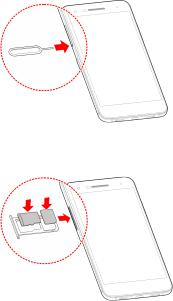
2.Pull out the card tray. You can place a nano-SIM card on the right card slot, and place a microSD card on the left card slot, as shown. Carefully slide the tray back into place.
Charging the battery
Your phone’s battery should have enough power for the phone to turn on, find a signal, and make a few calls. You should fully charge the battery as soon as possible.
If the battery is low, there will be a pop-up message on the screen.
 NOTE:
NOTE:
Your phone supports QuickCharge 2.0. To use it, you need to buy the compatible QuickCharge accessories which are sold separately.
 WARNING!
WARNING!
Use only approved chargers and cables. The use of unapproved accessories could damage your phone or cause the battery to explode.
10
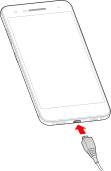
 WARNING!
WARNING!
Do not remove the back cover. The battery is not removable. Removal may cause fire or explosion.
1.Connect the adapter to the charging jack. Ensure that the adapter is inserted with the correct orientation. Do not force the connector into the charging jack.
2.Connect the charger to a standard AC power outlet. If the
phone is on, you’ll see a charging icon, such as  or
or  , appear on the status bar.
, appear on the status bar.
3.Disconnect the charger when the battery is fully charged.
 NOTE:
NOTE:
If the battery is extremely low, you may be unable to power on the phone even when it is being charged. In this case, try again after charging the phone for at least 20 minutes. Contact the customer service if you still cannot power on the phone after prolonged charging.
Extending the battery life
Active applications, screen brightness levels, Bluetooth and Wi-Fi usage and GPS functionality can drain your battery. You can follow the helpful tips below to conserve your battery power:
Use the Power Manager feature in Settings.
Reduce the screen backlight time.
11
Lower the screen brightness.
Turn Wi-Fi, Bluetooth and auto-sync off when not in use.
Disable the GPS function when not in use. Most applications using this function will periodically query the GPS satellites for your current location, and each query drains your battery.
Powering on/off
Press and hold the Power key to turn on your phone.
To power off, press and hold the Power key to open the options menu and touch Shut down > OK.
 NOTE:
NOTE:
If the phone freezes or takes too long to respond, you can press and hold the Power key for about 16 seconds to restart the phone.
Setting up for the first time
When you first power on your phone after you purchase it or reset it to factory settings (see Backup and reset), you need to do some settings before using it.
Touch the language field to select the language. Then follow the on-screen prompts to set up your phone.
Locking/unlocking the screen and keys
Your phone allows you to quickly lock the screen and keys (put the phone to sleep mode) when not in use and to turn the screen back on and unlock it when you need it.
To lock the screen and keys:
To quickly turn the screen off and lock the keys, press the
Power key.
 NOTE:
NOTE:
To save battery power, the phone automatically turns off the screen after some time of inactivity. You will still be able to receive messages and calls while the phone screen is off.
To unlock the screen and keys:
1.Press the Power key to turn the screen on.
-or -
Double-tap on the screen to turn it on.
12

 NOTE:
NOTE:
To enable this feature, select  > Settings > Display > Double tap to wake from the home screen.
> Settings > Display > Double tap to wake from the home screen.
2.Swipe up on the screen.
-or -
Swipe from a shortcut icon at the bottom to open the related app or feature.
- or -
Touch a notification twice consecutively to open the related app.
 NOTE:
NOTE:
If you have set a fingerprint, an unlock pattern, a PIN or a password for your phone (see Protecting your phone with screen locks and Using your fingerprint), you’ll need to press your finger against the fingerprint sensor, draw the pattern or enter the PIN/password to unlock your screen.
 NOTE:
NOTE:
You can edit the shortcut icons on the lock screen. Select
 > Settings > Display > Edit lock screen shortcuts from the home screen, touch a shortcut to change it, or touch Add shortcut to add one.
> Settings > Display > Edit lock screen shortcuts from the home screen, touch a shortcut to change it, or touch Add shortcut to add one.
Using the touch screen
Your phone’s touch screen enables you to control actions through a variety of touch gestures.
Touch
When you want to type using the onscreen keyboard, select items on the screen such as the application and settings icons, or press the onscreen buttons, simply touch them with your finger.
13

Touch and Hold
To open the available options for an item (for example, a message or link in a web page), touch and hold the item.
Swipe or Slide
To swipe or slide means to quickly drag your finger vertically or horizontally across the screen.
Drag
To drag, press and hold your finger with some pressure before you start to move your finger. While dragging, do not release your finger until you have reached the target position.
Pinch
In some apps (such as Maps, web browser, and Gallery), you can zoom in and out by placing two fingers on the screen at once and pinching them together (to zoom out) or spreading them apart (to zoom in).
14

Rotate the screen
For most screens, you can automatically change the screen orientation from portrait to landscape by turning the phone sideways.
 NOTE:
NOTE:
The auto-rotate feature needs to be enabled for the screen orientation to automatically change. Touch  >
>  > Settings > Display > When device is rotated and select Rotate the contents of the screen.
> Settings > Display > When device is rotated and select Rotate the contents of the screen.
You can also access the screen rotation control by sliding down the status bar twice, slide left and touch
Auto-rotate/Portrait.
Getting to know the home screen
The home screen is the starting point for your phone’s applications, functions, and menus. You can customise your home screen by adding shortcuts, folders, widgets, and more.
Status bar Google search
Folder
Shortcut
Primary shortcuts
15
Extended home screen panels
Your home screen is extendable, providing more space for shortcuts, widgets, and more. Simply swipe left or right on the home screen to see the extended panels. You can add or remove home screen panels, or adjust their order.
To add a new home screen panel:
1.Touch and hold an empty area of the home screen to access the home screen thumbnails.
2.Slide left until + appears.
3.Touch + to create a new home screen panel.
To adjust the order of a home screen panel:
1.Touch and hold an empty area of the home screen and slide left or right to view the home screen thumbnails.
2.Touch and hold a thumbnail and drag it left or right to the place you need.
To open your favourite home screen app:
You can slide right on the home screen to open your favourite app quickly.
1.Slide right on the home screen to access the leftmost home screen.
2.Slide right on the screen to open your favourite app.
 NOTE:
NOTE:
Touch  >
>  > Settings > Display and touch Favourite app panel to turn on or off this feature, or touch Favourite home screen app to select your favourite app.
> Settings > Display and touch Favourite app panel to turn on or off this feature, or touch Favourite home screen app to select your favourite app.
To lock or unlock your home screen layout:
After the home screen layout is locked, you cannot add/remove /adjust the home screen panel, or add/remove/move items on the home screen.
1.Touch and hold an empty area of the home screen to access the home screen thumbnails.
2.Touch  /
/ to lock/unlock the home screen layout.
to lock/unlock the home screen layout.
 NOTE:
NOTE:
You can also touch  >
>  > Settings > Display and touch Lock home screen layout to lock or unlock the home screen layout.
> Settings > Display and touch Lock home screen layout to lock or unlock the home screen layout.
16
Personalising
Changing the system language
1.Touch  >
>  > Settings > Languages & input > Languages. The first language in the list is the default system language.
> Settings > Languages & input > Languages. The first language in the list is the default system language.
2.Touch Add a language to add another language to the list. Select the regional variant of the language if prompted.
3.To change the system language, touch and hold  next to the language you want and drag it to the top of the list.
next to the language you want and drag it to the top of the list.
 NOTE:
NOTE:
To remove languages from the list, touch  > Remove and select the languages you want to delete.
> Remove and select the languages you want to delete.
Setting the date and time
1.Touch  >
>  > Settings > Date & time.
> Settings > Date & time.
2.Set the date, time, time zone, and time format.
To adjust the date and time automatically, turn on
Automatic date & time.
To adjust the date and time manually, turn off
Automatic date & time and touch Set date / Set time to change the date and time.
To adjust the time zone automatically, turn on
Automatic time zone.
To adjust the time zone manually, turn off Automatic time zone and touch Select time zone to set the correct time zone.
To adjust the time format, touch Use 24-hour format.
Changing ringtone and notification sound
You can customise the default incoming call ringtone and the default notification sound.
1.Touch  >
>  > Settings > Sound.
> Settings > Sound.
2.Touch Phone ringtone or Default notification ringtone.
3.Select the ringtone you want to use.
17
 NOTE:
NOTE:
If you have additional audio files saved in the internal storage or the microSD card, touch More Ringtones or More Notifications on the top of the ringtone list to choose one as the ringtone.
4. Touch OK.
 NOTE:
NOTE:
See Set a ringtone for a contact for how to assign a special ringtone to an individual contact.
 NOTE:
NOTE:
To make the phone ringtone fade in when a call comes, switch on Gradually increase ringtone.
Turning on/off system sounds
1.Touch  >
>  > Settings > Sound > Other sounds.
> Settings > Sound > Other sounds.
2.Touch Dial pad tones, Screen locking sounds, Touch sounds, or Vibrate on tap.
Adjusting volume
1.Touch  >
>  > Settings > Sound.
> Settings > Sound.
2.Drag the sliders below Media volume, Alarm volume and Ring volume to adjust the volume for each type of audio.
 NOTE:
NOTE:
You can adjust the media volume when a media application is in use by pressing the Volume key. If no media application is active, press the Volume key to adjust ringtone volume (or the earpiece volume during a call).
Using do not disturb mode
You can limit interruptions with Do not disturb mode. This mode silences your phone so that it doesn’t make sounds or vibrate when you don’t want it to.
To turn on Do not disturb mode:
1.Swipe down from the top of the screen with two fingers to access the Quick Settings.
2.Touch  (Do not disturb).
(Do not disturb).
18
3.Touch Total silence, Alarms only, or Priority only depending on whether you want to allow exceptions. You can customise the exceptions when Priority only is selected.
4.Touch Until you turn this off if you want to turn off Do
not disturb mode manually; touch  or
or  to set the time before Do not disturb mode turns off automatically.
to set the time before Do not disturb mode turns off automatically.
5.Touch DONE.
 NOTES:
NOTES:
Press and hold the Power key and touch  to turn on Alarms only quickly, or touch
to turn on Alarms only quickly, or touch  to turn on vibration.
to turn on vibration.
Press the Volume key when no media application is active to show the volume bar. Drag the slider to the left or keep pressing the Volume down key to turn on vibration. Press the key again to turn on Alarms only.
To turn off Do not disturb mode quickly, press either end of the Volume key and then touch END NOW when the screen is on, or press and hold the Power key and touch  .
.
To set exceptions for Do not disturb mode (Priority only):
You can set reminders, events, and callers that you specify as exceptions when Do not disturb mode is set to Priority only.
1.Touch  >
>  > Settings > Sound > Do not disturb > Priority only allows.
> Settings > Sound > Do not disturb > Priority only allows.
2.Turn on the switch next to the items you want to allow. Touch Messages or Calls and set who can alert you of their messages or calls.
 NOTE:
NOTE:
When Repeat callers is switched on, you’ll receive a notification if someone calls you a second time within a 15 minute period, regardless of whether notifications from that person receive priority status.
To set a Do not disturb rule:
If you want to allow all notification alerts through most of the time, but want to limit alerts during certain times (like at night or on the weekends), you can set a rule for Do not disturb mode.
1.Touch  >
>  > Settings > Sound > Do not disturb > Automatic rules.
> Settings > Sound > Do not disturb > Automatic rules.
19
2.Touch Add rule.
3.Enter the rule name, select Time rule or Event rule.
4.Enter a name for the rule and touch OK.
5.For a time rule, set the days, the start and end times, and set Do not disturb mode. You can also choose whether to allow the rule to stop at either the rule end time or by the next alarm you've set in the Clock app.
For an event rule, select a Calendar account you want to make the rule for, select the type of reply you want to use, and set Do not disturb mode.
 NOTE:
NOTE:
To turn on or off a rule, touch it to open its details screen and then touch the on/off switch.
To block visual disturbances:
You can set Do not disturb mode to block visual disturbances such as notifications.
1.Touch  >
>  > Settings > Sound > Do not disturb > Block visual disturbances.
> Settings > Sound > Do not disturb > Block visual disturbances.
2.Touch the on/off switches to choose whether to block visual notifications when the screen is on and off.
Applying new wallpapers
You can set the wallpaper for the home screen and lock screen.
1.Touch and hold an empty place on the home screen and then touch WALLPAPERS.
2.Slide left or right on the wallpaper panel to select a wallpaper or animation, or touch My photos to choose the image you want to use as the wallpaper. Pinch on the image to crop it if needed.
3.Touch Set wallpaper and select to set the wallpaper for the home screen, the lock screen or both.
 NOTE:
NOTE:
In addition, you can touch  >
>  > Settings > Display > Wallpaper to pick an image from Gallery, Photos or Wallpapers, or an animation from Live Wallpapers.
> Settings > Display > Wallpaper to pick an image from Gallery, Photos or Wallpapers, or an animation from Live Wallpapers.
20
Changing screen brightness
1.Touch  >
>  > Settings > Display > Brightness level.
> Settings > Display > Brightness level.
2.Drag the slider to manually adjust the screen brightness.
 NOTE:
NOTE:
Your phone can automatically adjust the screen brightness for available light. Touch Adaptive brightness in the Display settings screen to turn the feature on or off.
Using night mode
You can enable night mode to adjust the warm filter for eye care, or set a schedule when night mode will be turned on.
1.Touch  >
>  > Settings > Display > Night mode.
> Settings > Display > Night mode.
2.Turn on the switch to enable night mode. - or -
If you want to set a schedule when night mode will be turned on automatically, touch Scheduled to switch it on and set the start/end time.
3.Drag the slider below Warm filter intensity to adjust the eye care effect when night mode is on.
Protecting your phone with screen locks
You can protect your phone by creating a screen lock. When it is enabled, you need to swipe up on the screen, draw a pattern or enter a numeric PIN or password to unlock the phone’s screen and keys.
1.Touch  >
>  > Settings > Security > Screen lock.
> Settings > Security > Screen lock.
2.Touch None, Swipe, Pattern, PIN or Password.
Touch None to disable the screen lock.
Touch Swipe to enable screen lock and allow unlocking with a ‘swipe' gesture. You can unlock the screen by touching the display and sliding up.
Touch Pattern to draw and redraw a pattern that you must draw to unlock the screen.
Touch PIN or Password to set a numeric PIN or a password that you must enter to unlock the screen.
21
3.For Pattern, PIN, or Password lock, select whether to protect your phone by requiring your pattern, PIN or password before it starts up. Then follow the onscreen prompts to continue.
 NOTE:
NOTE:
When this feature is enabled, your phone cannot receive calls, messages, or notifications until it starts up.
4.For Pattern, PIN, or Password lock, select how you want notifications and their contents to show when the phone is locked. Then touch DONE.
 NOTE:
NOTE:
Remember the pattern, PIN or password you set. Otherwise, you will have to upgrade the phone software to use the phone.
Using your fingerprint
With the fingerprint sensor on the back of your phone, you can register up to 5 fingerprints and use them to unlock the phone or access Private Space, or simply press the fingerprint sensor to take photos or answer calls. You can also swipe down on the fingerprint sensor to open the notification panel.
 NOTE:
NOTE:
The fingerprint feature is only usable when the screen lock (Pattern, PIN or Password) is enabled. When the screen lock is reset to None or Swipe, all registered fingerprints are erased.
To register a fingerprint:
1.Touch  >
>  > Settings > Security > Fingerprint.
> Settings > Security > Fingerprint.
2.Enter the screen lock pattern, PIN or password you set. If you haven’t set a screen lock, follow the prompts to set it.
3.Touch REGISTER or Fingerprint > Add fingerprint.
4.Follow the prompts to record a finger.
5.Touch DONE.
 NOTE:
NOTE:
Touch an existing fingerprint record to change its name or delete it.
To set fingerprint actions:
1.Touch  >
>  > Settings > Security > Fingerprint.
> Settings > Security > Fingerprint.
2.Enter the screen lock pattern, PIN or password you set.
22
3.You can set the following options.
Access Private Space: Press the fingerprint sensor to access Private Space with a registered fingerprint. See Private Space.
Take photo: Press the fingerprint sensor to take a photo when the Camera app is opened. No fingerprint verification is needed.
Answer call: Press the fingerprint sensor to answer incoming calls. No fingerprint verification is needed.
View notification panel: Swipe down on the fingerprint sensor to open the notification panel.
Protecting your phone with screen pinning
You can use the screen pinning feature to keep an app in view, so others cannot switch to other apps or access your personal information.
Turn on screen pinning
1.Touch  >
>  > Settings > Security > Screen-pinning.
> Settings > Security > Screen-pinning.
2.Touch the On/Off switch.
3.If you want to ask for the unlock pattern, PIN or password before unpinning the screen, switch on Ask for unlock pattern / PIN / password before unpinning when the screen lock has been set.
Pin a screen
1.Ensure that screen pinning is turned on.
2.Open the app you want to keep in view.
3.Touch  .
.
4.If there are many app tabs, swipe up to find  on the front-most tab.
on the front-most tab.
5.Touch  .
.
Unpin the screen
To unpin the screen and return to normal use, touch and hold
 .
.
If you have asked for the unlock pattern, PIN or password before unpinning the screen, swipe up on the lock screen and draw the pattern or enter the PIN/password. You can also unlock the screen with your fingerprint if you have registered one.
23

Knowing the basics
Monitoring the phone status
The status bar at the top of the home screen provides phone and service status icons on the right side. Below are some of the icons you may see.
|
EDGE connected |
|
No signal |
|
|
|
|
/ |
3G/HSPA+ |
|
Signal strength |
connected |
|
||
|
|
|
|
|
|
|
|
|
4G connected |
|
Flight mode |
|
|
|
|
|
Do not disturb mode |
|
|
|
on (Alarms only or |
|
Bluetooth® on |
|
Priority only) |
|
|
|
|
|
|
|
Do not disturb mode |
|
Connected to a |
|
on (Total silence) |
|
Wi-Fi® network |
|
Vibration on |
|
Speaker on |
|
|
|
|
|
Battery low |
|
Phone microphone |
|
|
off |
|
|
|
|
|
|
|
|
|
|
Battery full |
|
GPS on |
|
|
|
|
/ |
Battery charging |
|
Portable Wi-Fi |
|
hotspot on |
||
|
|
||
|
Alarm set |
|
Wired headset |
|
|
connected |
|
|
|
|
|
|
|
|
|
Managing notifications
Notification icons
The status bar at the top of the home screen provides notification icons on the left. Below are some of the icons you may see.
|
|
|
New Wi-Fi |
|
New SMS/MMS |
|
network |
|
|
|
detected |
|
|
|
|
/ |
New message(s) |
|
Downloading |
from the Email app |
|
data |
|
|
|
||
|
|
|
|
|
24 |
|
|

|
New message(s) |
|
|
/ |
from the Gmail™ |
|
Sending data |
|
app |
|
|
|
|
|
|
|
Missed call |
|
USB tethering |
|
|
on |
|
|
|
|
|
|
|
|
|
|
Call in progress |
|
microSD card |
|
|
mounted |
|
|
|
|
|
|
|
|
|
|
Call on hold |
/ |
Song playing |
|
|
|
|
Open/close the notification panel
Notifications report the arrival of new messages, calendar events, and alarms, as well as ongoing events, such as when you are playing music. You can open the notification panel to view the details of notifications.
To open the notification panel, swipe your finger down from the top of the screen.
To close the notification panel, swipe your finger up on the screen or touch  .
.
Respond to or remove a notification
In the notification panel, you can respond to a notification or remove the notifications. The notification panel also supports expandable notifications that let you perform additional actions right from the notification itself.
To respond to a notification, just touch it.
Slide down with one finger to expand certain notifications. You can also swipe two fingers vertically or pinch-zoom to expand or collapse certain notifications, or touch  /
/ to expand or collapse certain notifications and bundled notifications.
to expand or collapse certain notifications and bundled notifications.
You can take quick actions on some notifications. For example, you can expand a new message notification and reply it.
To remove a notification, swipe it left or right.
To remove all non-persistent notifications, touch CLEAR ALL below all the notifications.
25
To manage notifications you have received, touch and hold a notification, or slide it left or right a small amount and touch  , and then choose to silence or block the application, or touch MORE SETTINGS to customise more notification settings. See Notifications.
, and then choose to silence or block the application, or touch MORE SETTINGS to customise more notification settings. See Notifications.
 NOTE:
NOTE:
If you block notifications for an app, you may miss its important alerts and updates.
Use Quick Settings
The Quick Settings make it convenient to view or change the most common settings for your phone.
Open the notification panel and you can find a few Quick Settings on the top. To open the Quick Settings panel and find all setting tiles, drag the notification panel downwards, or swipe down from the top of the screen with two fingers.
 NOTE:
NOTE:
You can swipe left or right on the Quick Settings panel to find all setting tiles.
To turn on or off settings quickly:
1.Swipe down from the top of the screen with two fingers to open the Quick Settings panel.
2.To turn on or off a setting, touch its tile. Touch and hold certain tiles to access more setting options. For example, touch and hold the Wi-Fi tile to open Wi-Fi settings.
To customise the Quick Settings panel:
You can add, remove or rearrange the tiles on the Quick Settings panel.
1.Open the Quick Settings panel.
2.Touch  at the top and do one of the following.
at the top and do one of the following.
Touch and hold a tile and drag it to the position you want.
Touch and hold a tile and drag it to the section below to hide it.
In the Drag to add tiles section, drag a tile up to show it in the Quick Settings panel.
 NOTES:
NOTES:
Additional setting tiles may appear after you use the functions they control.
26
On the Quick Settings panel, touch  at the top to get to
at the top to get to
the Settings menu; touch  to manage users or switch between them.
to manage users or switch between them.
Managing shortcuts and widgets
Add shortcuts and widgets
1.Touch  >
>  . - or -
. - or -
To add widgets, touch and hold an empty area of the home screen and select WIDGETS.
2.Slide up or down to browse the available applications or widgets.
3.Touch and hold a widget or an application icon and drag it to a home screen panel.
 NOTE:
NOTE:
While holding the item, you can drag it to the right edge of the screen to create a new home screen panel and put the item on it.
Move shortcuts or widgets
1.Touch and hold a shortcut or widget on the home screen.
2.Drag it to the place you need.
Remove shortcuts or widgets
1.Touch and hold a shortcut or widget on the home screen.
2.Drag it to  (Remove) to remove it.
(Remove) to remove it.
Adjust widget size
1.Touch and hold a widget on the home screen and then release it.
2.An outline appears around the widget. Drag the outline to resize the widget.
 NOTE:
NOTE:
Not all widgets can be resized.
Organising with folders
You can create folders on the home screen and add several shortcuts to a folder.
27

You can move or remove folders the same way as moving or removing shortcuts.
1.Touch and hold a shortcut on the home screen and drag it quickly over another shortcut.
2.Release the shortcut. A new folder will be created and both shortcuts are added into the folder.
3.To add more shortcuts into the folder, touch and hold each shortcut and drag it over the folder before releasing it.
 NOTE:
NOTE:
Touch the folder and then touch the name field to rename the folder.
Rearranging the primary shortcuts
The home screen includes a customisable primary shortcuts area at the bottom visible from all home screens. You can keep at most four items in the primary shortcuts area. Drag shortcuts or folders in or out of the area to rearrange it.
Entering text
You can enter text using the onscreen keyboard. Some apps open it automatically. In others, you open it by touching where
you want to type. Touch  to hide the onscreen keyboard. You can also enter text by speaking with the Google voice typing feature.
to hide the onscreen keyboard. You can also enter text by speaking with the Google voice typing feature.
Enable or disable input methods
1.Touch  >
>  > Settings > Languages & input > Virtual keyboard.
> Settings > Languages & input > Virtual keyboard.
2.Touch Manage keyboards.
3.Slide the switches beside the input methods to enable or disable them.
 NOTE:
NOTE:
Some default input methods may not be disabled.
Change input methods
1.When you use the onscreen keyboard to enter text, touch the icon  at the bottom right corner of the screen.
at the bottom right corner of the screen.
2.Select the input method you need.
28
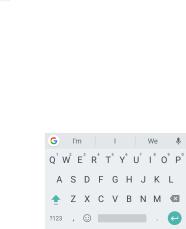
 NOTE:
NOTE:
The icon  appears only when more than one input method is installed and enabled.
appears only when more than one input method is installed and enabled.
Gboard
Gboard provides a layout similar to a desktop computer keyboard. When screen auto-rotation is enabled, turn the phone sideways and the keyboard will change from portrait to landscape. The landscape keyboard is not supported in all applications.
Touch the alphabetic keys to enter letters. Touch and hold some specific keys to enter associated accented letters or numbers. For example, to enter È, touch and hold  and the available accented letters and number 3 appear. Then slide to choose È.
and the available accented letters and number 3 appear. Then slide to choose È.
As you enter a word, candidates appear above the keyboard. Touch to select the correct one.
Touch  to use uppercase. Double-tap
to use uppercase. Double-tap  to lock uppercase. This key also changes to indicate the current case you are using:
to lock uppercase. This key also changes to indicate the current case you are using:  for lowercase,
for lowercase,  for uppercase, and
for uppercase, and  when locked in uppercase.
when locked in uppercase.
Touch  to delete the text before the cursor.
to delete the text before the cursor.
Touch  to select numbers and symbols. You can then touch
to select numbers and symbols. You can then touch  to find more or touch
to find more or touch  to enter miniature icons, such as expressions, horoscopes, and animals.
to enter miniature icons, such as expressions, horoscopes, and animals.
Touch  to use Google voice typing.
to use Google voice typing.
Touch and hold  to change the input language or set up Gboard.
to change the input language or set up Gboard.
29
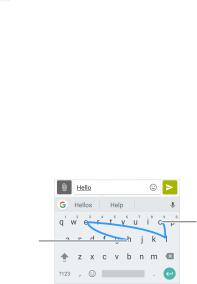
Touch and hold  and then slide right to change the keyboard layout for one-hand input.
and then slide right to change the keyboard layout for one-hand input.
Touch  to access more options.
to access more options.
 NOTE:
NOTE:
The keyboard layout may change in different apps.
Glide Typing
Gboard supports the glide typing feature. You can use this feature to input a word by sliding through the letters.
To enable and use glide typing:
1.Touch and hold  on Gboard and then touch Gboard keyboard settings.
on Gboard and then touch Gboard keyboard settings.
2.Touch Glide typing and then touch Enable glide typing if this feature is turned off.
3.Move your finger from letter to letter on the keyboard to trace a word without lifting the finger until you reach the end of the word.
End of Start of the word
the word
 NOTES:
NOTES:
Touch when you want to. If you want to enter a single letter, go ahead and touch.
Lift your finger at the end of the word. A space is added automatically when you begin to input the next word.
Google voice typing
Google voice typing uses the Google voice recognition service to convert speech to text.
1.Touch  to access the voice typing feature when you are using Gboard.
to access the voice typing feature when you are using Gboard.
Or touch  at the bottom right and select Google voice typing.
at the bottom right and select Google voice typing.
30
